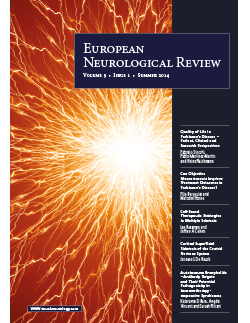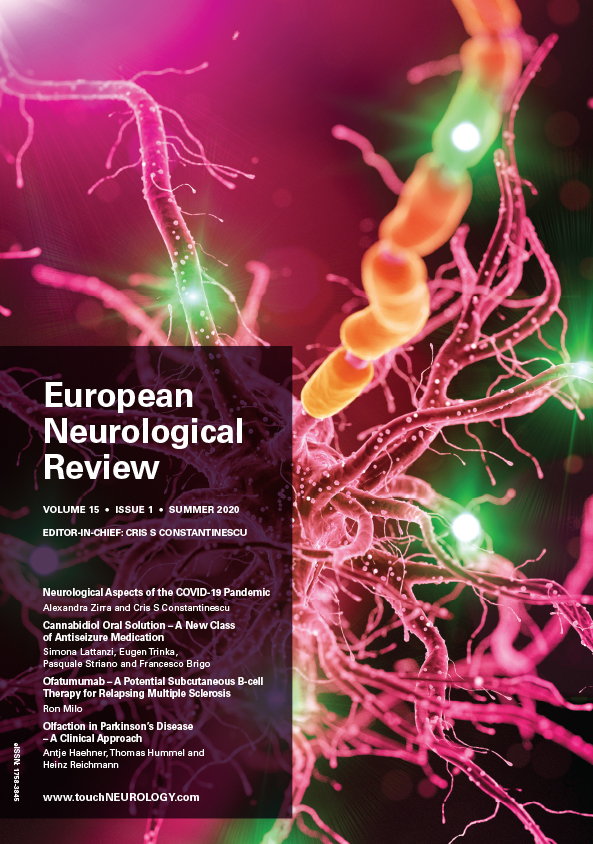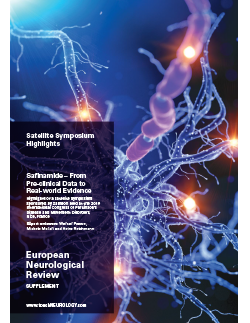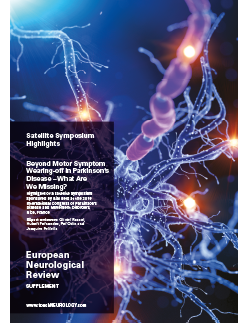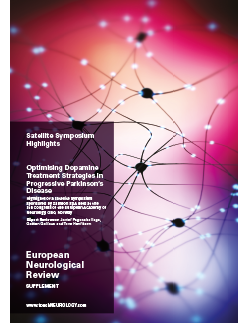EUROPEAN NEUROLOGICAL REVIEW – VOLUME 9 ISSUE 1 – SUMMER 2014
Welcome to the summer edition of European Neurological Review. It is an exciting time for neurology in Europe, as we eagerly anticipate the imminent joint congress of the European Neurological Society (ENS) and the European Federation of Neurological Societies (EFNS) and the birth of their unified organisation, the European Academy of Neurology (EAN). Both societies are our valued media partners – we wish them much success and look forward to continuing our fruitful relationship with them as the EAN. This edition presents an insightful selection of review articles by leading experts – look out for complimentary print copies at the joint congress in Istanbul. The foreword is provided by Jacques De Reuck, who played a key role in the creation of the EAN, and who sums up the ethos of our journal, when he says, “These concise review articles are essential as they allow European neurologists to be aware in a quick way of all recent progresses in their field of interest.”
Welcome to the summer 2014 edition of European Neurological Review. As usual this issue contains a variety of review articles on new developments in neurological diseases. The main topics addressed include Parkinson’s disease, multiple sclerosis, stroke, headache, neuromuscular disorders, neurometabolic disorders and autoimmune encephalitis. These concise review articles are essential as they allow European neurologists […]
Introduction to Apomorphine and its Role in the Treatment of Parkinson’s Disease Andrew Lees Professor of Neurology, National Hospital for Neurology and Neurosurgery, London. Apomorphine is a highly-potent dopamine agonist (DA) that, unlike other clinically available compounds in this class, selectively acts on both D1 and D2 dopamine receptors and has been shown in a […]
Movement Disorders - Parkinson's Disease
Parkinson’s disease (PD) is a chronic condition that imposes a substantial burden on patients and their caregivers. The disease has a profound and progressive impact on various neurological functions, but its aetiology is not fully understood. There are an estimated seven to 10 million people with PD worldwide (including 1.2 million in Europe); it is […]
In Parkinson’s disease (PD) the assessment of quality of life (QoL) using various measures is increasingly important to determine disease status and to assess the efficacy of new and existing treatments from the patients’ point of view. In the past, health-related quality of life (HRQoL) measures using generic and specific instruments such as the SF-36 […]
‘You can’t manage what you can’t measure’ is a well-acknowledged maxim attributed variously to Peter Drucker, W Edward Demming and Bill Hewlett (of Hewlett Packard), but was probably first expressed by Lord Kelvin, the British scientist associated with, among other discoveries, the first and second law of thermodynamics. It is a concept well entrenched in […]
Highlights of a Satellite Symposium Held at the XX World Congress on Parkinson’s Disease and Related Disorders, Geneva, Switzerland, 8–11 December 2013 Parkinson’s disease (PD) is a progressive neurodegenerative disorder, characterised by motor features but is also associated with a broad spectrum of non-motor symptoms (NMS). Oral levodopa, dopamine agonists or monoamine oxidase type B […]
Multiple Sclerosis
Multiple sclerosis (MS) is a chronic immune-mediated neurodegenerative disorder characterised by central nervous system (CNS) demyelination, axonal injury, gliosis and eventual loss of both oligodendrocytes and neurons.1 The aetiology of the disease is complex, and not entirely understood, though human and animal studies of immune-mediated demyelinating disease has elucidated some components of MS pathophysiology.2,3 Genetic […]
Multiple sclerosis (MS) is a chronic, often disabling, neurologic disease, common among adults worldwide and in the US.1 It has a heterogeneous geographical prevalence with higher rates reported in Central and Northern Europe, North America, and Australia than for Asia, Africa, and South America.2 There are believed to be over 400,000 persons with MS in […]
Impact of Multiple Sclerosis on Health-related Quality of Life Patients with multiple sclerosis (MS) suffer from myriad symptoms, including pain, fatigue, depression, bowel/bladder dysfunction and sleep disturbances. Understandably, the effects of MS on patients’ vitality and physical, emotional, social, cognitive and sexual function negatively impact their health-related quality of life (HRQoL).1–4 The relative burden of […]
Stroke
Stroke remains a major killer worldwide, causing 5.7 million deaths in 2004 alone.1One in six people in the world will suffer a stroke in their lifetime: in Europe, stroke afflicts close to 10 million people.2,3 For survivors, stroke is disabling, with major negative effects on the quality of life of stroke victims and their family/carers.4–7 […]
Every year, more than 15 million people worldwide suffer from a stroke, making it the third most common cause of death in developed countries.1 Another serious aspect of stroke is that 50 % of stroke survivors remain long-term disabled causing limited mobility and dependency in activities of daily living (ADL).1 Considering the established claim of […]
Lacunar strokes (LACS), which result from occlusion of the deep penetrating arteries in the brain, are often milder than embolic or large vessel strokes.1 Even if they are mild in terms of stroke severity, it has been recognized that LACS often are associated with cognitive impairment.2 The cognitive profile may differ from that of primary […]
Cortical superficial siderosis (cSS) of the central nervous system is considered a rare condition, observed on gradient echo T2*- weighted magnetic resonance imaging (MRI) as a typical signal hypointensity outlining the brain surface. It is detected as a characteristic curvilinear pattern preferentially affecting the cerebral convexities.1 It reflects haemosiderin deposition in the subpial space, which […]
Headache
Headache is the most common somatic complaint seen in the emergency department, accounting for 1 % to 3 % of all emergency department visits.1 Given the range of headache-related disorders, a systematic approach to headache classification and diagnosis is essential for best clinical management.2 Apart from the most common types of primary headaches (migraine, tension-type […]
Neuromuscular Disorders
Report based on Presentations at a Satellite Symposium held at the European Paediatric Neurology Society (EPNS) on 25 September 2013 in Brussels, Belgium At the European Paediatric Neurology Society (EPNS) conference held in Brussels during September 2013, a satellite symposium sponsored by PTC Therapeutics Inc. was held to discuss new perspectives in the management of […]
Neurometabolic Disorders
Pompe disease (PD, glycogen storage disease type II, OMIM # 232300) is an autosomal recessive lysosomal storage disease caused by deficiency of acid alpha-glucosidase (GAA) (acid maltase, EC 3.2.1.20) due to mutations in the GAA gene.1 Progressive storage of intra-lysosomal glycogen in skeletal, cardiac, and smooth muscle cells leads to impairment of cellular integrity and […]
Autoimmune Encephalitis
Autoantibody-mediated diseases of the central nervous system (CNS) are a rapidly expanding field within contemporary neuroimmunology. Autoimmune encephalitis (AIE) is a treatable cause of subacuteonset memory loss and confusion. In some patients, the evidence for inflammation is limited and the term autoimmune encephalopathy may be preferred. The associated spectrum of autoantibodies against specific molecules in […]

Trending Topic
Welcome to the latest edition of touchREVIEWS in Neurology. We are excited to present a collection of articles that showcase the latest advancements and diverse perspectives in neurological research and treatment. This issue features insightful reviews and editorials from esteemed experts, providing valuable insights into modern management strategies and novel therapeutic approaches for various neurological […]
Journal Archive
European Neurological Review is a peer-reviewed, free-to-access, bi-annual neurology journal comprising review articles, case reports, practice guides, theoretical discussions, and original research. It features balanced and comprehensive articles written by leading authorities, addressing the most important and salient developments in the field of neurology in practical terms.
Latest articles videos and clinical updates - straight to your inbox
Log into your Touch Account
Earn and track your CME credits on the go, save articles for later, and follow the latest congress coverage.
Register now for FREE Access
Register for free to hear about the latest expert-led education, peer-reviewed articles, conference highlights, and innovative CME activities.
Sign up with an Email
Or use a Social Account.
This Functionality is for
Members Only
Explore the latest in medical education and stay current in your field. Create a free account to track your learning.


